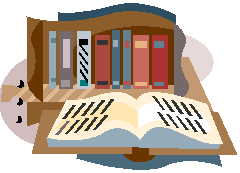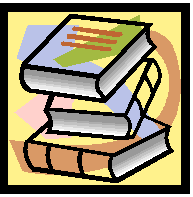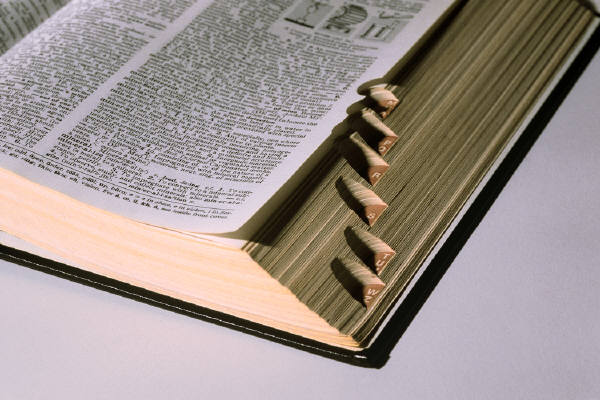

A bibliography is a systematic listing of resources of various kinds: books, journal articles, book chapters, and electronic resources such as Web sites. Librarians use bibliographies in large part for identification and verification of citations, and to provide their patrons with suggestions for reading. In particular, they can be used to identify what materials are available by format, subject, author, or producer. They may also provide information about where an item may be found, either within the library or in another library, or where it can be purchased or rented. Some bibliographies are intended for selection purposes, with recommended materials listed by age levels, subject areas, or authors. In addition, patrons will use bibliographies for further study on many levels, from school reports to professional research.
All bibliography entries will contain the following:
Depending on its purpose, a bibliography may include:

You should be aware of the following books, although most of them are probably too expensive for a small library. They are standard reference sources -- some of the best-known and often-used in libraries.
Guide to Reference Books, ed. by Robert Balay. 11th ed. American
Library Association, 1996.
Perhaps the most comprehensive source and certainly one of the best-known within
the library community, it lists the two or three most authoritative references in
every discipline and field of knowledge. Annotated entries are arranged by
subject/Library of Congress classification number. Updated irregularly.
Recommended Reference Books for Small and Medium-Sized Libraries and Media
Centers, ed. by Bohdan S. Wynar. Libraries Unlimited, Inc. Annual.
An abridged version of American Reference Books Annual (ARBA), this contains
about a third of the reviews in ARBA. Each entry includes the type
of library (academic, public, school) for which the books are appropriate.
Wilson Standard Catalogs. H. W. Wilson Company.
These five catalogs are annotated lists of titles; all but the Fiction Catalog
are arranged by Dewey Decimal numbers. It cannot be overemphasized how valuable
these catalogs can be to the small library. They are useful for book selection,
weeding, and as readers' advisory tools; the books have been carefully chosen
by librarians using specific evaluative criteria. Author, title, and subject
indexes are included. All have main volumes, published every five years, with
annual updates. The Wilson catalogs may be affordable for all but the smallest
libraries. They are available both in print and online by subscription; see
http://www.hwwilson.com for more details.
They include:
Children's Catalog - fiction and nonfiction, including story collections,
picture books and magazines for readers preschool through sixth grade.
Middle and Junior High School Library Catalog - for grades 5 - 9, includes
fiction, nonfiction, CD-ROMs, curriculum support materials and professional aids
for library staff.
Senior High School Library Catalog - for grades 9 - 12; type of materials
covered are the same as Middle and Junior High School Library Catalog.
Public Library Catalog - contains recommended adult nonfiction, largely those
works published in the United States.
Fiction Catalog - lists exclusively fiction for adults; especially useful
for readers' advisory services.
Books in Print. 9 volumes. R. R. Bowker Company.
The most comprehensive source for all books published in the United States that
are currently in print. Records include author, title, publisher, date of
publication, price, LC card number and ISBN. Books in Print (BIP),
published annually, is used to obtain complete ordering information or to verify
titles. While it is a time-honored reference tool in the library world, small
libraries should be able to get the ordering information they need from an Internet
bookseller's site such as amazon.com or barnesandnoble.com. BIP is
available in print, on CD-ROM and online by subscription through several vendors,
including the publisher, http://www.bowker.com.
In addition to the main BIP set, the series includes several other titles;
for example:
Subject Guide to Books in Print - an index to BIP by subject.
Children's Books in Print - the portion of BIP devoted exclusively
to children's books.
El-Hi Textbooks and Serials in Print - textbooks, serials, teaching aids
and AV materials for the K-12 grades.
The Complete Directory of Large Print Books and Serials - a variety of materials
on varying levels, all printed in 14-point type or larger.
Forthcoming Books - a bimonthly publication of soon-to-be published titles.
While the bibliographies mentioned here are, for the most part, print resources in book form, you may encounter a bibliography that comes from the end of a journal or encyclopedia article, a section of a book, a Web site, or simply a flyer or brochure.
A note of caution: watch out for the patron who confuses the terms "bibliography" and "biography." Few things are so disheartening as to locate or print out the complete list of books by Mark Twain ("a bibliography of Mark Twain books"), when the story of his life (a biography) is what was wanted.

Click the arrow below to continue to the next page